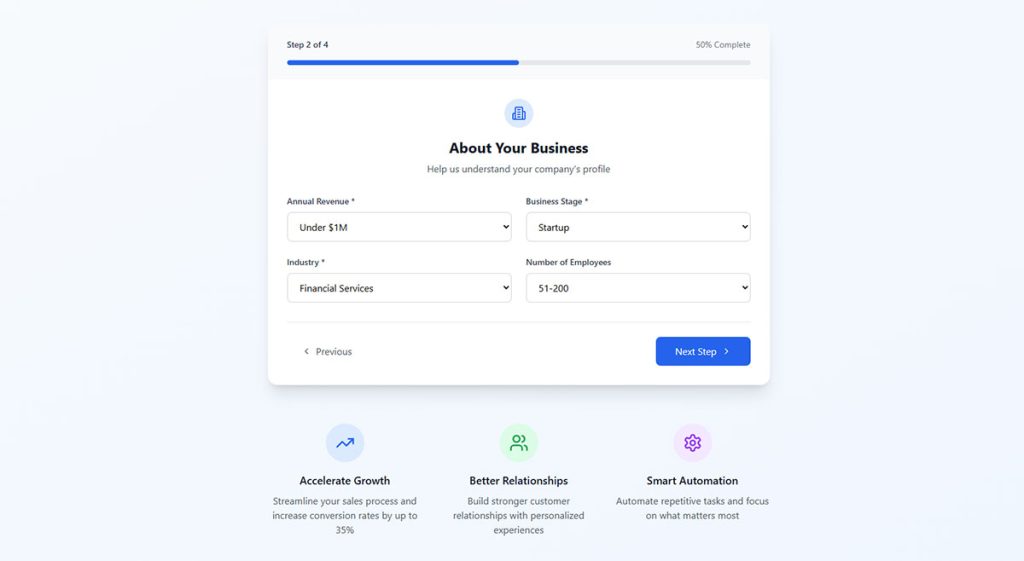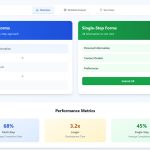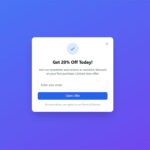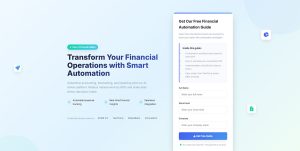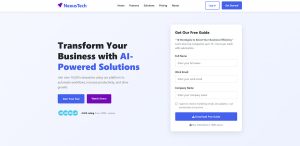Your photography website gets decent traffic, but visitors leave without booking. They browse your portfolio, maybe check your pricing page, then vanish into the void of comparison shopping. Lead magnets…
Table of Contents
Your conversion rates tell a brutal truth: most forms collect contacts, not customers.
The best form fields for capturing high-quality leads separate serious buyers from casual browsers. Poor field selection wastes marketing budgets and frustrates sales teams with unqualified prospects.
Smart companies use strategic form design to identify purchase intent, budget authority, and timeline urgency. The right fields predict which leads become customers while the wrong ones drive prospects away.
This guide reveals field combinations that boost both conversion rates and lead quality. You’ll discover contact information strategies, business qualification questions, and technical implementation tactics that transform your lead generation results.
Learn how platforms like HubSpot, Marketo, and Salesforce handle progressive profiling. Master mobile optimization, CRM integration, and A/B testing approaches that consistently outperform generic contact forms.
Essential Form Fields vs Comprehensive Form Fields
| Comparison Aspect | Essential Form Fields (Minimalist Approach) |
Comprehensive Form Fields (Detailed Data Collection) |
|---|---|---|
| Lead Quality Score | High (8/10)
Lower friction increases conversion
|
Medium (6/10)
Higher qualification but lower volume
|
| Conversion Rate Impact | ↑ 25-40% Higher
Reduced form abandonment
|
↓ 15-30% Lower
Increased cognitive load
|
| Required Fields Count | 3-5 Fields
Email, Name, Phone/Company
|
8-12 Fields
Demographics, budget, timeline, etc.
|
| Lead Nurturing Requirement | High Intensity
Requires extensive qualification process
|
Low Intensity
Pre-qualified leads ready for sales
|
| Sales Cycle Acceleration | Moderate
Discovery phase extends timeline
|
Accelerated
Upfront data shortens sales process
|
| Cost Per Qualified Lead | Lower ($)
Higher volume compensates quality
|
Higher ($$$)
Premium cost for premium data
|
| Optimal Use Cases | B2C Lead Generation • Newsletter subscriptions • Product demos • Content downloads • Event registrations |
B2B Enterprise Sales • High-ticket software sales • Consulting services • Custom solutions • Account-based marketing |
| Data Privacy Compliance | Simplified
Minimal PII collection reduces risk
|
Complex
Extensive data requires robust policies
|
| Recommendation | Best for maximizing lead volume and early-stage audience building | Ideal for high-value B2B sales with longer consideration cycles |
Must-Have Basic Contact Fields
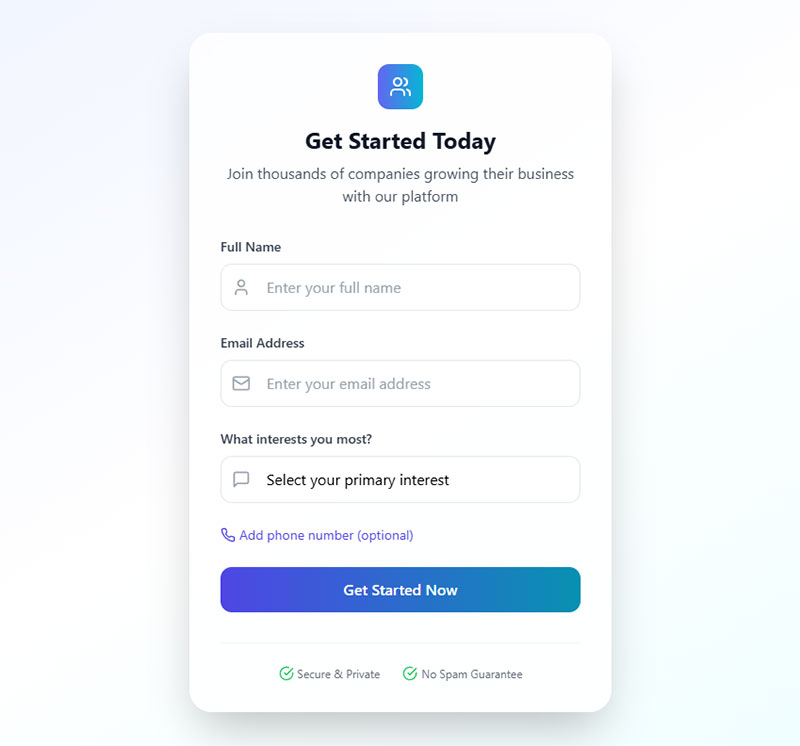
Your lead generation strategy starts with getting the basics right. Contact information forms the foundation of every customer relationship, but collecting it requires careful planning.
85% of marketers say lead generation is their top measure in 2024, making contact field optimization critical for business growth. However, only 38% of users who interact with contact forms successfully submit their details, highlighting the importance of strategic field selection.
Name Field Configuration
Single vs. separate name fields creates your first design decision.
Single name fields work better for conversion rates because users complete them faster with less friction. The name field has the shortest average completion time at 3.5 seconds and the lowest field return figure at 0.3, making names one of your safest required fields from a user experience perspective. However, personalization becomes harder later in your marketing funnel.
First and last name fields separately give you better data organization that HubSpot and Salesforce prefer. Your email marketing campaigns can use proper personalization tokens, but you’ll sacrifice some conversion efficiency.
Required vs. optional name fields impacts lead quality significantly. Making names required increases data completeness but reduces form completion rates. Optional name fields let anonymous visitors convert easier, while progressive profiling helps bridge this gap over time.
International name formats add complexity since some cultures use multiple surnames or single names. Your form validation system needs flexibility for global prospects.
Email Address Collection Best Practices
Email addresses are your most valuable lead data. Get this field wrong and lose potential customers forever.
Email marketing is the most effective lead generation channel, with 48% of marketers saying it’s their top method. This makes email collection absolutely essential for nurturing prospects. Email collection forms convert at an average rate of 15%, significantly outperforming standard contact forms.
Single email field with proper validation beats complicated setups every time. Email fields have an abandonment rate of 6.4%, making them one of the more challenging fields after passwords. Real-time validation catches typos immediately, while Gmail, Yahoo, and Outlook domains handle most business traffic.
Email confirmation fields create unnecessary friction. Skip them unless you’re processing payments or handling sensitive data. Modern browsers and mobile keyboards reduce typos naturally.
Corporate vs. personal email preferences matter for B2B lead scoring:
- Company domain emails (@company.com) usually indicate decision-making authority
- Personal emails (@gmail.com) might suggest employees researching for their employers
- Your lead scoring system should weight these differently
Phone Number Field Optimization
Phone collection strategies vary widely across industries. B2B companies often need immediate contact capability, while B2C brands might skip phones entirely.
Including a phone number field causes an average 5% dip in conversion rates. Unless your business relies on post-click sales calls, avoid making this field required. Research shows that changing phone number fields from mandatory to optional decreases abandonment from 39% to just 4%.
Phone number fields have an abandonment rate of 6.3%, similar to email fields but without the same business value for most companies. Testing shows mixed results across industries, with one company seeing a 47% decrease in conversions when adding phone number fields to their ebook download form.
Required vs. optional phone collection depends on your sales process. Required phone fields can cut conversion rates by 20-30%, but sales teams love having immediate contact options. Consider these guidelines:
- Make phone optional for content downloads and early-stage offers
- Require phone numbers only for high-intent actions like demos or consultations
- Test optional phone fields first, then measure lead quality differences
- B2C brands typically skip phone collection entirely
International format considerations get technical quickly. Country code dropdowns help but add complexity. Auto-formatting based on country selection improves user experience significantly.
Mobile vs. landline preferences shift constantly. Most business contacts prefer mobile numbers now, and your contact forms should accommodate both. SMS follow-up campaigns work better with mobile numbers, while mobile forms need touch-friendly input fields.
Form Length and Performance Impact
HubSpot research of 40,000 customer contact forms found conversion rates improve by almost 50% when form fields reduce from four to three. This single change can double your lead volume without any other modifications.
Over 30% of marketers report highest conversion rates from forms with 4 fields, but limiting forms to just 3 fields can guarantee a minimum 25% conversion rate. When deciding what to keep, prioritize:
- Name (fastest completion at 3.5 seconds)
- Email (essential for follow-up)
- Primary qualifying question relevant to your business
- Skip phone numbers unless absolutely necessary
Multi-page forms have a 13.85% average completion rate compared to 4.53% for single-page forms. Break longer forms into multiple steps to reduce perceived complexity, but ensure each step provides clear value to maintain momentum.
Device-Specific Optimization
Desktop users convert at 5.06% while mobile trails at 2.49%, but mobile commands around 65% of total traffic compared to desktop’s 32%. This makes mobile optimization essential despite lower conversion rates.
Desktop forms show a 47% view-to-starter rate compared to 42% for mobile. Users on smaller screens face additional friction when entering information, requiring careful attention to touch-friendly design elements.
Customers on tablet and desktop devices have average conversion rates of 3.6%, significantly higher than mobile users. Touch-friendly design becomes critical with larger input fields, proper spacing, and simplified layouts to help mobile users complete forms successfully.
Trust and Conversion Enhancement
Adding social proof to forms can increase conversion rates by 26%. Display customer counts, testimonials, or security badges near your contact forms to build immediate credibility.
Privacy statements matter more than ever in our data-conscious environment. Tell users exactly what happens with their information and guarantee no spam or data sharing to reduce hesitation. Effective trust-building elements include:
- SSL certificates and security badges
- Clear privacy policy links
- “No spam” guarantees
- Customer testimonials near forms
- Industry certifications or awards
Industry-Specific Benchmarks
Professional services achieve the highest form conversion rates at 9.2% to 9.3%, while B2B services average 2.2% and B2B eCommerce hits just 0.7%. Financial industry leads with 5.2% conversion rates, followed by professional services at 5.0%.
Industries with lower conversion rates include:
- B2B technology and real estate: 1.7%
- Travel and healthcare: 1.9%
- B2B eCommerce: 0.7%
Understanding your industry baseline helps set realistic expectations and identify improvement opportunities for your specific market context.
Business Information Fields That Matter
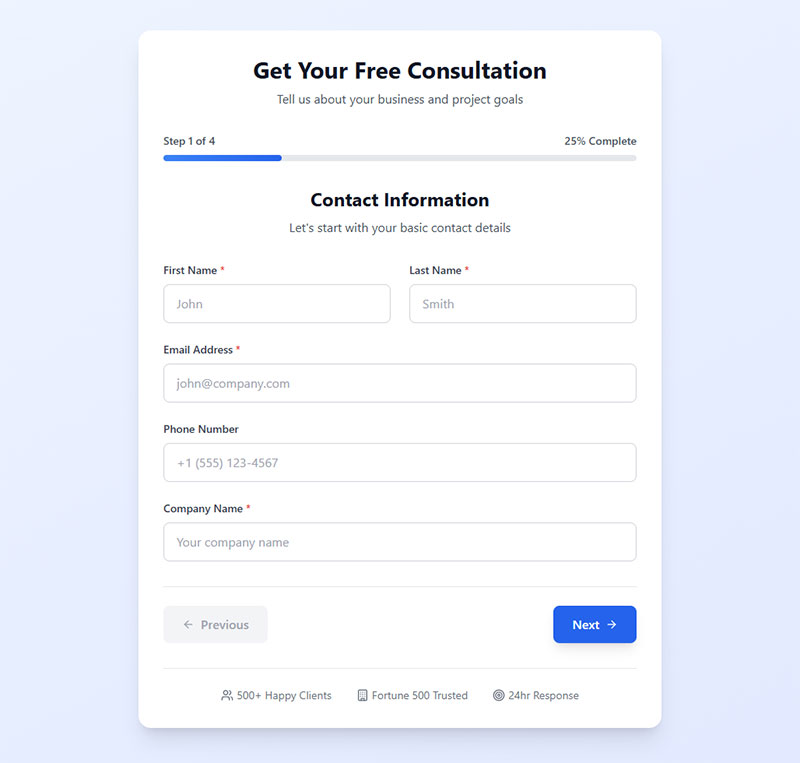
Business details separate qualified prospects from casual browsers. These fields help your sales team prioritize follow-up efforts effectively.
59% of B2B marketers believe email is their most effective channel for generating revenue, but collecting the right business information determines whether those email campaigns convert into sales.
However, B2B buyers have become more cautious, and the time it takes to convert a lead into a sale is getting longer – low-cost deals can take up to three months to close, while higher value deals can fall between six to nine months.
Company Name and Size Fields
Company information reveals prospect value and sales approach needs.
Free-text vs. dropdown company selection each have advantages. Free-text fields capture exact company names, including subsidiaries and divisions. Auto-complete features speed up well-known company entry, but 84% of people prefer to fill out forms on a laptop or desktop computer, with only 3% preferring mobile devices for complex form interactions.
Dropdown selections standardize data but limit new company discovery. Companies with aligned sales and marketing teams are 103% more likely to outperform those with misaligned teams, making standardized company data crucial for lead scoring accuracy.
Company size ranges should align with your sales segments:
- Standard ranges like 1-10, 11-50, 51-200, 201-1000, 1000+ employees work for most B2B companies
- Some industries need revenue-based sizing instead
- Match your existing customer segments for better lead scoring
- Professional services achieve the highest form conversion rates at 9.2% to 9.3%, while B2B eCommerce hits just 0.7%
Solo entrepreneurs and small business owners need special consideration. “Just me” options acknowledge their reality. “Planning to hire” fields capture growth intent. These prospects often become excellent long-term customers despite initially appearing as smaller opportunities.
Job Title and Role Fields
Decision-making authority varies dramatically across organizations. Job titles help identify real buying power.
Free-text vs. predefined job title options both serve different purposes. Predefined options speed up form completion, and common titles like CEO, Marketing Manager, IT Director work well. But modern job titles get creative fast – “Growth Hacker” and “Customer Success Ninja” won’t fit standard lists.
Grouping roles by decision-making authority improves lead qualification:
- C-level executives usually control budgets directly
- Managers influence decisions but need approval
- Individual contributors research solutions but rarely purchase them
- Your lead scoring should reflect these differences
B2B purchasing decisions rarely happen in isolation – prospects often need to convince 4-6 other stakeholders before anything happens. Smart lead qualification accounts for this reality by understanding the full buying committee structure.
Identifying key stakeholders requires understanding complex B2B buying processes. 77% of B2B consumers do extensive research before making a purchase, and multiple people influence software purchases now. Account-based marketing strategies need comprehensive contact mapping to succeed.
Industry and Sector Classification
Industry data helps customize your marketing messages and sales approaches.
Standard industry classification systems provide consistency. NAICS codes offer government-standardized options, while SIC codes remain popular for older systems. But most prospects don’t know these technical classifications – plain language works better for user experience.
Industries with the highest form conversion rates include industrial (2.8%), professional services (2.5%), and B2B services (2.2%). The lowest form conversion rates are found in real estate (0.6%), B2B eCommerce (0.7%), and B2C eCommerce (0.8%).
Custom industry categories work better for niche markets. Software companies might use “SaaS,” “E-commerce,” and “Digital Agencies” instead of broad technology categories. Healthcare splits into “Hospitals,” “Clinics,” and “Medical Device Manufacturers.” Match your customer language, not government databases.
Multiple industry selection helps modern businesses. Companies often operate across sectors. “Primary industry” and “secondary industries” fields capture this complexity without overwhelming users.
Progressive Profiling Strategy
When used correctly, progressive profiling can increase conversion rates by 20%. It’s the procedure of gathering lead data in accordance with lead interest, starting with basic information and building comprehensive profiles over time.
Your lead capture forms need balance between comprehensive data collection and user experience. Too many fields kill conversions, while too few fields reduce lead quality. The key is strategic timing of information requests.
Dynamic forms can increase conversion rate by as much as 160% by showing different fields based on what information you already have about each prospect. Most marketing automation platforms from leading vendors provide dynamic web form features.
Testing different field combinations reveals what works for your specific audience:
- Start simple with name, email, and company name
- Add job title and company size for returning visitors
- Request industry and budget information for high-intent actions
- Collect detailed requirements only for demo requests
Marketo and Pardot customers often see better results with progressive profiling approaches. Start simple, then add complexity gradually as prospects demonstrate higher engagement levels.
Form Optimization and Integration
Almost 50% of marketers agree that web forms are their highest converting lead generation tool, but proper integration remains challenging. ActiveCampaign, ConvertKit, and Mailchimp each handle custom fields differently. Plan your data structure before building forms.
Marketers who run A/B tests on their forms report conversion rates that are 10% higher on average than those who don’t use split tests to optimize their forms. However, 36% of marketers never run user tests on their forms, missing significant optimization opportunities.
Integration with marketing automation platforms requires careful field mapping:
- Map job titles to lead scoring rules
- Connect company size to sales territory assignment
- Link industry data to content personalization
- Sync budget information with opportunity scoring
Only 40% of marketers use multi-step forms, but their conversion rate is 86% higher than traditional single-page forms. Consider breaking complex business information collection across multiple interactions.
Remember that lead quality matters more than lead quantity. Better business information fields help your sales team close more deals faster by providing the context needed for personalized outreach and accurate lead prioritization.
Qualification and Intent Fields
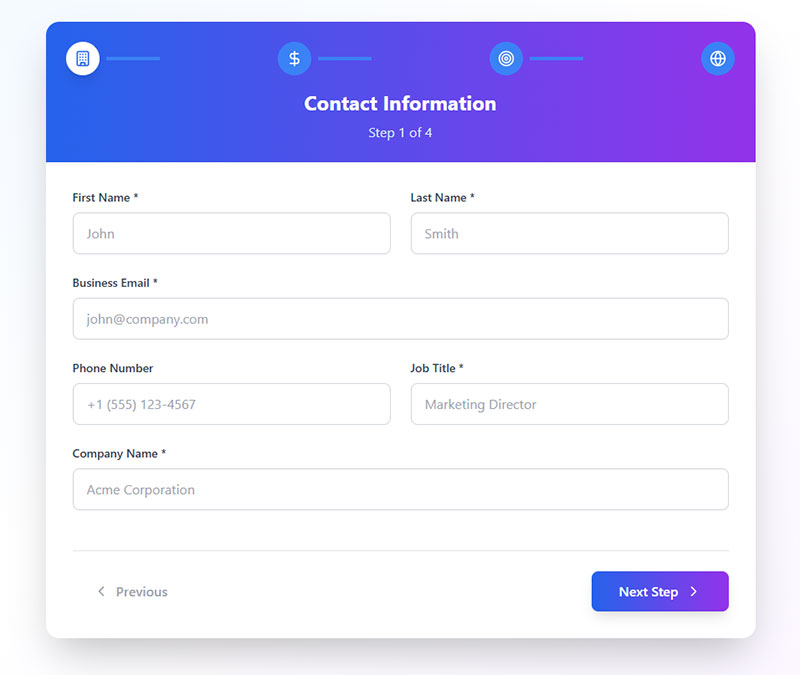
Qualification questions separate serious buyers from casual browsers. These fields predict purchase likelihood and sales cycle length.
Budget and Investment Level Fields
Budget information guides sales approach and resource allocation.
Budget range selections should match your pricing tiers exactly.
Create ranges that align with your service packages. If your solutions cost $5K-$50K annually, use ranges like “Under $5,000,” “$5,000-$15,000,” “$15,000-$35,000,” and “$35,000+.” Avoid ranges that split your pricing structure awkwardly.
Timeline questions reveal purchase urgency. “Immediate need,” “Next quarter,” “6-12 months,” and “Just researching” options help prioritize follow-up. Immediate needs get hot lead treatment in CRM integration workflows.
Current solution and switching motivation fields uncover competitive intelligence.
Ask about existing tools or providers. “Currently using [competitor]” or “No current solution” responses require different sales approaches. Switching costs and contract renewal dates affect timing strategies.
Specific Need and Pain Point Fields
Understanding prospect challenges helps customize your sales pitch and marketing messages.
Multiple choice vs. open-text problem identification each serve different purposes.
Multiple choice options speed up completion while standardizing responses for lead scoring. Common pain points like “Scaling operations,” “Reducing costs,” or “Improving efficiency” work well for most B2B companies.
Open-text fields capture unique situations but require manual review. Sales teams appreciate context but marketing automation struggles with unstructured data.
Urgency level and priority ranking questions help queue follow-up activities.
“Critical priority,” “Important but not urgent,” and “Nice to have” options guide sales team response times. Critical priorities need same-day follow-up. Nice-to-have prospects enter nurturing sequences.
Current situation descriptions provide conversation starters. “What’s your biggest challenge with [topic]?” questions generate detailed responses that sales teams can reference during initial calls.
Project Scope and Requirements
Scope information helps match prospects with appropriate sales resources and solution configurations.
Service or product category selections streamline qualification processes.
If you offer multiple services, let prospects indicate primary interests. “Marketing automation,” “Sales enablement,” and “Customer support” categories help route leads to specialist teams.
Team size and project complexity indicators predict implementation effort. Small teams need different onboarding than enterprise deployments. Your multi-step forms can progressively reveal scope details.
Geographic location affects service delivery capability. Local service requirements, time zone preferences, and regulatory compliance needs vary by region.
Progressive Profiling and Advanced Fields
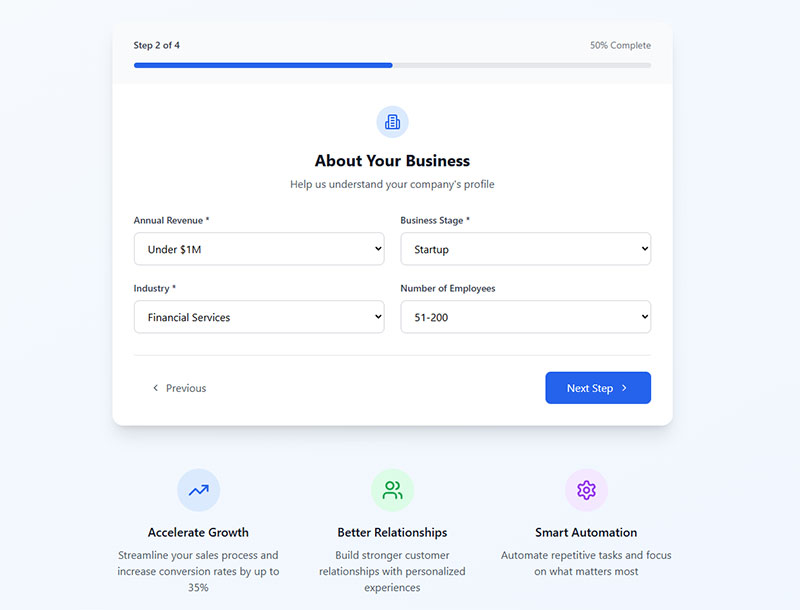
Progressive profiling balances comprehensive data collection with conversion optimization. Smart forms adapt based on visitor behavior and existing data.
When to Use Progressive Profiling
Progressive profiling works best for complex B2B sales cycles with multiple touchpoints.
Multi-step form strategies reduce initial friction while building detailed profiles over time.
Start with email capture and basic contact information. Add business details on second visit. Include qualification questions for repeat engagers. HubSpot and Marketo excel at progressive profiling automation.
Returning visitor field updates keep data current without overwhelming users.
Hide previously completed fields. Show new questions based on engagement history. Update outdated information through targeted campaigns. Conditional logic helps customize experiences.
Balancing immediate capture with detailed profiling requires testing different approaches. Some prospects prefer completing everything once. Others abandon lengthy forms immediately.
Advanced Demographic Fields
Detailed demographics enable precise targeting and personalization.
Revenue range and business maturity indicators help segment prospects effectively.
Revenue ranges like “Under $1M,” “$1M-$10M,” “$10M-$100M,” and “$100M+” align with typical business growth stages. Startup, growth, and enterprise phases need different messaging strategies.
Technology stack questions reveal integration requirements. “Current CRM,” “Marketing tools,” and “Analytics platforms” responses help technical sales teams prepare for discussions.
Team structure and organizational setup information guides sales approaches.
Centralized vs. distributed teams affect implementation strategies. Remote-first companies have different needs than traditional offices. Decision-making processes vary with organizational structure.
Behavioral and Preference Fields
Behavioral data improves marketing automation and sales personalization.
Communication preferences and frequency options respect prospect autonomy while optimizing engagement.
Email frequency choices like “Weekly updates,” “Monthly newsletters,” and “Major announcements only” reduce unsubscribe rates. Phone contact preferences prevent unwanted interruptions.
Content interests help segment email lists and content recommendations. “Industry reports,” “Case studies,” “Webinars,” and “Product updates” preferences enable targeted campaigns through platforms like ConvertKit and ActiveCampaign.
Event attendance and engagement history indicates sales readiness.
Webinar attendees often have higher purchase intent than whitepaper downloaders. Multiple content engagements suggest active research phases. Your lead scoring system should weight behavioral indicators heavily.
Form UX design becomes critical with advanced fields. Poor design kills completion rates regardless of field value. Test layouts extensively before implementing complex profiling strategies.
Integration with customer data platforms requires careful planning. Salesforce, Pardot, and other enterprise systems handle progressive profiling differently. Map your data architecture before building advanced forms.
Remember that data quality decreases as form length increases. Balance comprehensive profiling with practical completion rates. Your sales team needs actionable information, not exhaustive profiles.
Technical Implementation and Field Types
Form field selection directly impacts user experience and data quality. Choose the wrong field type and watch conversion rates plummet.
Form Field Types and When to Use Them
Text fields come in two main varieties with distinct purposes.
Single-line text fields work for names, emails, and company information. Keep them short and specific. Multi-line text areas handle detailed responses like project descriptions or pain point explanations.
WordPress forms and most form builders default to single-line fields. Override this for questions needing elaborate answers.
Dropdown menus organize complex option sets efficiently.
Single selection dropdowns work for industry categories, company sizes, and budget ranges. Multiple selection options help when prospects fit several categories. Avoid dropdowns with more than 15 options without search functionality.
Radio buttons vs. checkboxes serve different data collection needs.
Radio buttons force single selections for mutually exclusive choices. Budget ranges, urgency levels, and timeline preferences work well with radio buttons. Checkboxes allow multiple selections for interests, challenges, or service needs.
Mobile users struggle with small radio buttons. Increase touch target sizes for better mobile forms experience.
Validation and Error Handling
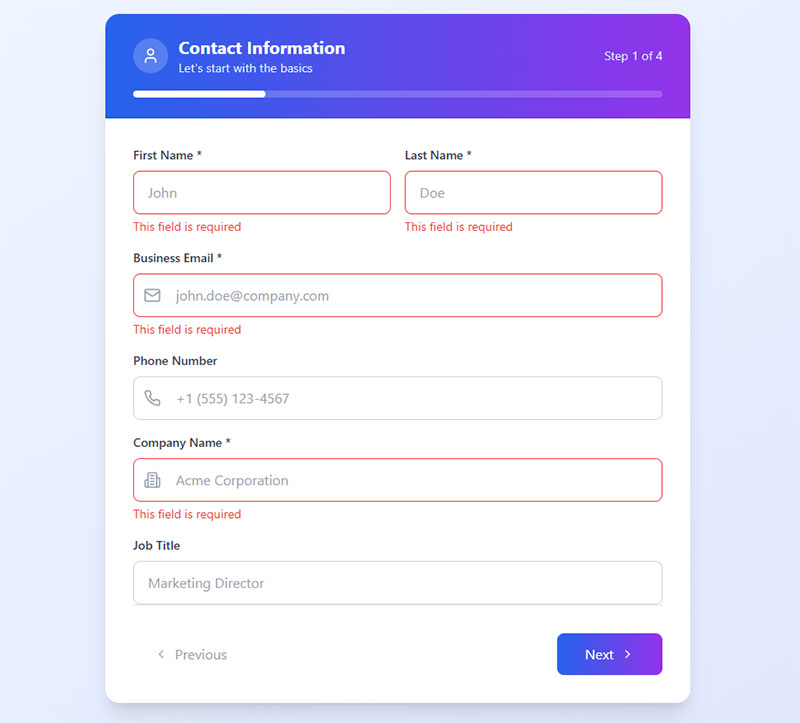
Real-time validation prevents submission errors and improves user experience significantly.
Real-time validation catches problems immediately rather than after submission.
Email format validation stops typos before completion. Phone number formatting helps users enter correct information. Required field indicators show completion progress clearly.
Clear error messages guide users toward successful completion.
Generic “Field required” messages frustrate users. Specific guidance like “Please enter a valid email address” or “Phone number should include area code” helps more. Form error message examples show effective communication styles.
Required field indicators reduce abandonment rates. Asterisks work but visual highlighting performs better. Progress bars help with longer forms.
Mobile Optimization for Form Fields
Mobile traffic dominates most websites now. Forms that work poorly on phones lose leads constantly.
Touch-friendly field sizing prevents input frustration.
Minimum 44px touch targets work for most users. Spacing between fields prevents accidental taps. Auto-zoom on input focus helps but can disorient users.
Keyboard optimization speeds up mobile completion.
Email fields should trigger email keyboards. Phone fields need numeric keypads. URL fields show appropriate keyboard layouts. These small details improve completion rates measurably.
Simplified layouts reduce cognitive load on smaller screens. Single-column designs work better than multi-column layouts. Form design principles apply differently on mobile devices.
Testing and Optimization Strategies
Continuous testing reveals optimization opportunities most companies miss. Data beats assumptions every time.
A/B Testing Form Field Combinations
Split testing form variations uncovers conversion improvements quickly.
Testing field quantity and order often produces surprising results.
Fewer fields usually increase completion rates but may reduce lead quality. Test 3-field forms against 7-field versions. Measure both conversion rates and lead qualification scores.
Field order affects completion psychology. Start with easy questions like name and email. Save qualification questions for the end when users are committed.
Required vs. optional field experiments balance data collection with user experience.
Making phone numbers optional might boost conversions 15-20%. But sales teams prefer having immediate contact options. Test the trade-off with your specific audience.
Field label and placeholder text variations impact user understanding.
“Company” vs. “Company Name” vs. “Organization” might perform differently. Placeholder text should provide examples, not repeat labels.
Measuring Form Performance
Track multiple metrics beyond basic conversion rates for complete optimization insight.
Completion rate tracking reveals where users abandon forms.
Google Analytics and form analytics tools show field-level abandonment. High abandonment at specific fields indicates problems. Heat mapping tools like Hotjar and Crazy Egg visualize user behavior patterns.
Lead quality scoring measures business impact beyond raw numbers.
Track which form variations produce leads that convert to customers. Higher conversion rates mean nothing if leads never buy. Your CRM integration should connect form data to sales outcomes.
Conversion rate optimization through field adjustment requires patience. Test one variable at a time for clean results. Statistical significance takes time with normal traffic volumes.
Continuous Improvement Process
Optimization never ends. Markets change, audiences evolve, and competitor strategies shift constantly.
Regular form audit and field relevance review keeps data collection current.
Quarterly reviews identify outdated fields and missing opportunities. Industry changes might require new qualification questions. Technology stack questions need updates as tools evolve.
Sales team feedback provides crucial lead quality insights.
Sales teams know which leads convert best. Regular feedback sessions reveal data gaps and quality issues. Their input guides field additions and removals effectively.
User feedback collection uncovers usability problems.
Feedback forms on completion pages gather improvement suggestions. Exit surveys capture abandonment reasons. User testing sessions reveal navigation issues.
Integration with platforms like Typeform, JotForm, and Wufoo enables sophisticated testing capabilities. Most form builders include A/B testing features now. WordPress contact form plugins offer basic split testing functionality.
Remember that improving form abandonment rate requires understanding user motivations. Technical improvements help, but value proposition clarity matters more.
Advanced form builders with conditional logic enable dynamic experiences. Test progressive disclosure against single-page forms. Some audiences prefer completing everything at once while others abandon lengthy forms immediately.
Integration with Sales and Marketing Systems
System integration transforms raw form data into actionable sales intelligence. Poor integration wastes leads and frustrates teams.
CRM Field Mapping and Data Flow
Matching form fields to CRM properties requires careful planning before launch.
Salesforce uses standard fields like First Name, Last Name, and Company. Custom fields handle industry-specific data like budget ranges or technology stack information. Map every form field to prevent data loss.
HubSpot automatically creates contact properties for new form fields. But consistent naming conventions prevent duplicate properties. “Company_Size” works better than “CompanySize” or “company size” variations.
Custom field creation and management gets complex quickly with multiple forms.
Create fields in your CRM before building forms. Test data flow with sample submissions. Marketo and Pardot require field types to match exactly between systems.
Data synchronization and update handling needs clear rules for conflicts.
Should new form data overwrite existing CRM records? Append to existing fields? Create activity logs? Define these rules early to prevent data corruption.
Lead Scoring and Qualification Automation
Automated scoring systems turn form responses into sales priorities instantly.
Assigning point values to different field responses requires understanding your sales process deeply.
C-level job titles might score 20 points while individual contributors score 5. Immediate timeline needs score higher than “just researching” responses. Budget ranges above your minimum threshold add significant points.
Automated lead routing gets qualified prospects to the right sales reps immediately.
Geographic territories often determine assignment. Enterprise accounts need senior reps while small businesses go to inside sales teams. Industry expertise matters for complex technical sales.
Trigger-based follow-up sequences maintain engagement without manual effort.
High-scoring leads trigger immediate sales alerts. Medium scores enter nurturing campaigns through ActiveCampaign or ConvertKit. Low scores get educational content sequences.
Data Quality and Maintenance
Clean data enables effective automation and accurate reporting.
Duplicate detection and management prevents database bloat and confused sales teams.
Email addresses serve as primary duplicate identifiers. But people use multiple emails or change companies. Define duplicate rules clearly and review matches regularly.
Data cleaning and standardization processes improve automation accuracy.
Company names need standardization. “IBM,” “International Business Machines,” and “IBM Corp” should merge into single records. Industry classifications require consistent formatting across all sources.
Regular database hygiene maintains system performance and data accuracy.
Monthly reviews identify incomplete records and outdated information. Quarterly audits catch systematic problems before they impact sales effectiveness. Annual deep cleans remove inactive prospects and update field structures.
Integration complexity varies dramatically between platforms. WordPress forms integrate easily with most CRM systems through plugins or webhook connections. Enterprise solutions like Pardot offer sophisticated field mapping but require technical expertise.
Landing page forms need seamless CRM integration for campaign tracking. Source attribution helps measure marketing ROI and optimize spending across channels.
API limitations affect real-time data flow. Some systems batch updates hourly while others sync immediately. Plan follow-up timing based on actual sync schedules, not theoretical capabilities.
Testing integration thoroughly prevents lost leads during peak campaign periods. Create test contacts in all systems. Verify data appears correctly in CRM records. Check automated workflows trigger appropriately.
Remember that sales teams rely on clean, complete data for effective outreach. Poor integration undermines even the best lead generation efforts. Investment in proper setup pays dividends through improved conversion rates and sales efficiency.
FAQ on Best Form Fields For Capturing High-Quality Leads
What fields are essential for every lead generation form?
Name, email, and company fields form the basic foundation. Add phone numbers for B2B sales processes requiring immediate contact. Include industry and company size for lead scoring. These core fields enable CRM integration and sales qualification without overwhelming prospects.
How many form fields should I include to maximize conversions?
Three to five fields optimize conversion rates for most businesses. Testing shows completion rates drop significantly beyond seven fields. Use progressive profiling through HubSpot or Marketo to gather additional data over time rather than requesting everything upfront.
Should phone numbers be required or optional fields?
Make phone numbers optional unless immediate contact is critical. Required phone fields reduce conversion rates by 20-30%. B2B companies often need direct contact capability, while B2C brands can skip phones entirely. Test both approaches with your audience.
What’s the difference between single name fields and separate first/last name fields?
Single name fields increase completion rates but limit personalization options. Separate first and last name fields enable better email marketing personalization and CRM organization. Salesforce and most marketing automation platforms prefer separated name data.
How do I collect budget information without scaring prospects away?
Use ranges that match your pricing tiers instead of exact amounts. “Under $5,000,” “$5,000-$15,000,” and “$15,000+” feel less invasive than specific budget questions. Position budget questions after establishing value through content or demos.
What business information fields help qualify leads effectively?
Company size, industry, and job title reveal buying authority and fit. Decision-making roles like CEO or Director score higher than individual contributors. Industry classifications help route leads to specialist sales teams and customize follow-up messaging.
How does progressive profiling improve lead quality over time?
Progressive profiling adds new fields for returning visitors while hiding completed information. Start with basic contact details, then add qualification questions on subsequent visits. This approach balances immediate conversion with comprehensive data collection through multiple touchpoints.
What form validation practices reduce abandonment rates?
Real-time validation catches errors immediately rather than after submission. Clear error messages guide users toward correct completion. Email format checking and phone number formatting help users enter valid information. Required field indicators show completion progress clearly.
How do I optimize forms for mobile users?
Use single-column layouts with touch-friendly field sizing. Trigger appropriate keyboards for email, phone, and numeric inputs. Increase spacing between fields to prevent accidental taps. Mobile forms need simplified designs compared to desktop versions.
What CRM integration considerations affect form field selection?
Match form fields to existing CRM properties before launch. Create custom fields in Salesforce or HubSpot first, then map form data appropriately. Consistent naming conventions prevent duplicate properties. Test data flow with sample submissions to verify accurate synchronization.
Conclusion
Implementing the best form fields for capturing high-quality leads transforms your entire sales pipeline. Strategic field selection balances conversion optimization with prospect qualification, turning casual visitors into sales-ready opportunities.
Your choice between subscription forms and comprehensive lead capture depends on your sales process complexity. B2B companies benefit from detailed business information fields, while B2C brands often succeed with minimal contact collection approaches.
Testing remains critical for optimization success. A/B test field combinations, validation methods, and mobile layouts continuously. Platforms like Gravity Forms, Ninja Forms, and Typeform offer built-in analytics to measure performance effectively.
Integration with ConvertKit, ActiveCampaign, and other marketing automation tools amplifies your results. Clean data flows enable personalized nurturing campaigns and accurate lead scoring systems.
Remember that lead quality trumps quantity every time. Well-designed forms with strategic field selection generate fewer contacts but significantly more customers.
